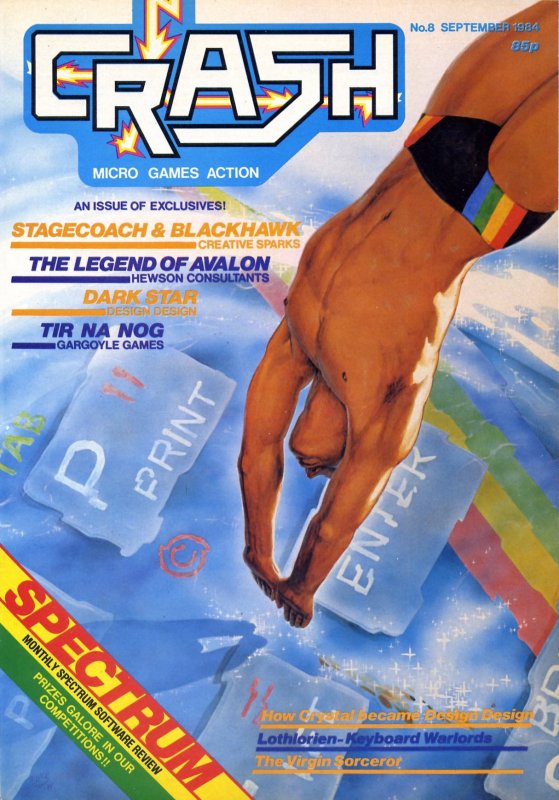

Again we have a summery cover to suit the season, and one that isn’t related to any game. This is a splendid example of the Spectrum device being used in a surreal manner to create effect. The distributor voiced a worry that readers wouldn’t be able to tell from the painting that it was a computer magazine. But one glimpse of that P-quotes-PRINT key was like a neon sign to any rubber-keyed Spectrum owner — and they were all rubber keys then. In order not to distract from the picture, the cover lines were kept, for CRASH, to a modest minimum.
The King Street offices are situated on three floors above a Victoria Wine shop in the very centre of Ludlow. In August, when CRASH moved in, only the top two floors were used, and they looked empty enough when we were all installed! The first floor was occupied by a subtenant who astonishingly enough was also in the computer business, a programmer of educational software.
Reception, mail order, subscriptions and administration went on the second floor, run by Franco Frey and Denise Roberts. Denise had joined Newsfield only a month or two after Matthew, to take over his mail order responsibilities when he was moved across to do CRASH reviews back in December 83.
Of the four rooms on the top floor, one became an art room for layout and one a writing room with two desks and typewriters, one held the process cameras and the other was used for photographing screens and as a photographic darkroom. It was great luxury to have all that breathing room, and at last a proper set up existed for receiving visits from software houses. Our first two such were notable. Graham Stafford and Simon Brattel of Crystal Computing came to tell the world that they were henceforth to be known as Design Design, and to give the reviewers a preview of Dark Star, just about the fastest 3-D vector graphics game ever written. And Gargoyle Games, in the form of Greg Follis, Ted Heathcote and Roy Carter, nipped over from Dudley to show us a game in a revolutionary new style for which Gargoyle was to become celebrated. It was Tir Na Nòg.
We were doing well for previews, for a day later Andrew Hewson appeared bearing gifts in the form of Steve Turner’s latest game, The Legend Of Avalon. This graphical adventure marked a distinct change of pace and 3-D style for Steve, and even in an unfinished form it looked very exciting. These early previews made CRASH’s manifesto of being first with new games, new software houses and innovations a reality. The ‘exclusives’ war was beginning to hot up, but we felt well satisfied with August!
When not hard at work looking after the business end of CRASH or reviewing utilities, Franco Frey wore his other hat as an engineer. For some months he’d been developing a hardware programmable interface for the Spectrum, and suddenly it was ready to market. We had tried out several prototypes in the office, and they made setting up joysticks much easier. It was the Frel Comcon, which was to become a huge success. Our preview was a rather easy scoop to make!
Hot games were more in the news than the reviews, although Creative Sparks’s Black Hawk was Smashed for its addictivity (certainly not its graphics whatever the ratings said), and of course there was the state-of-the-art sports simulation from Psion, Match Point. Derek provided the third: Adventure International’s The Hulk with its pretty graphics.
Legend provided us with hype when they announced The Great Space Race. The campaign relied heavily on the reputation of their Valhalla, although many suggested that Legend was busily recreating an aura of success around the earlier game greater than it really deserved in order to justify claims for The Great Space Race. ‘A spectacular futuristic romp ...’ said our News page hopefully, but there was to be a five-month wait to find out whether or not the hype would justify the hope.